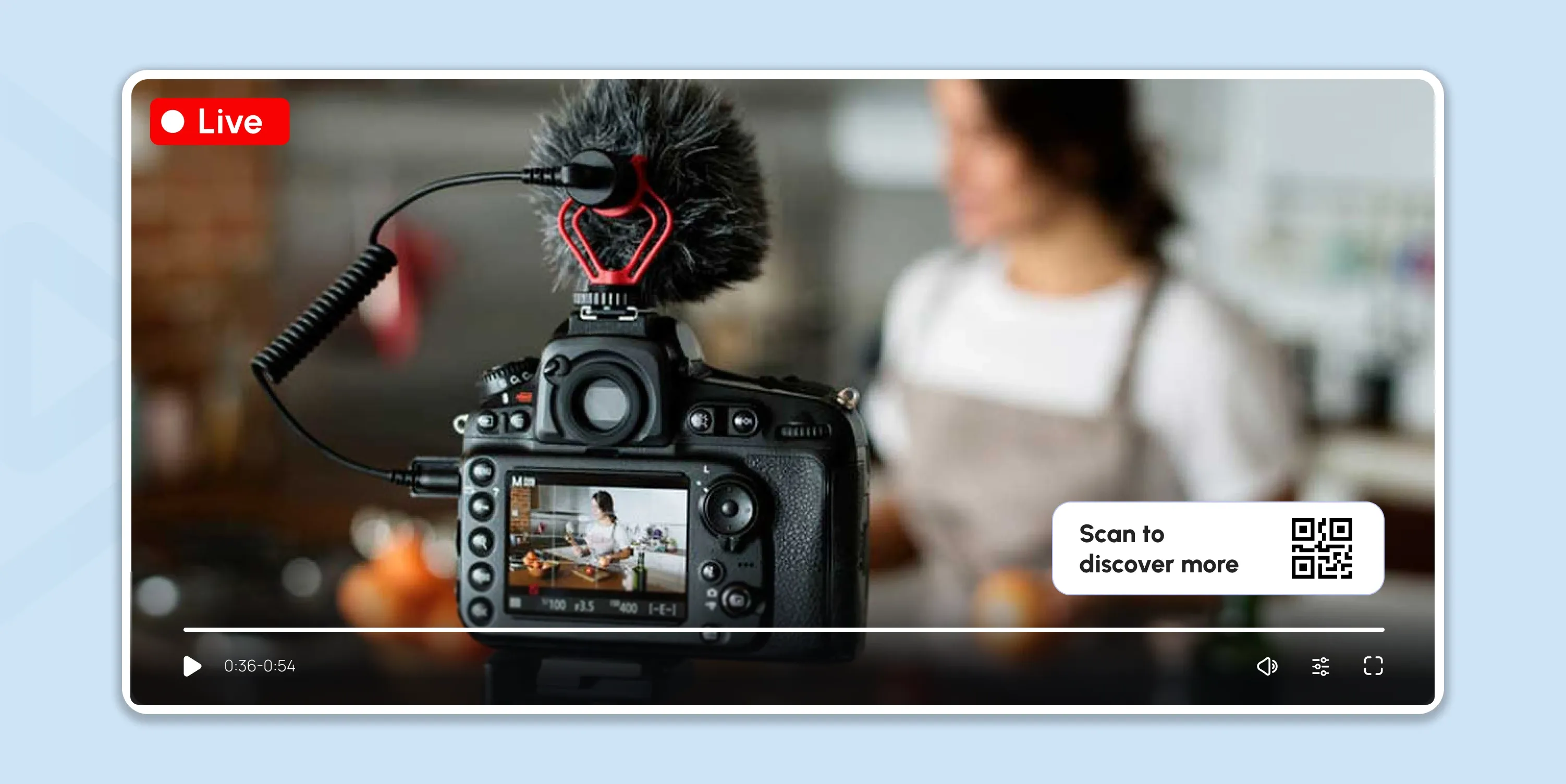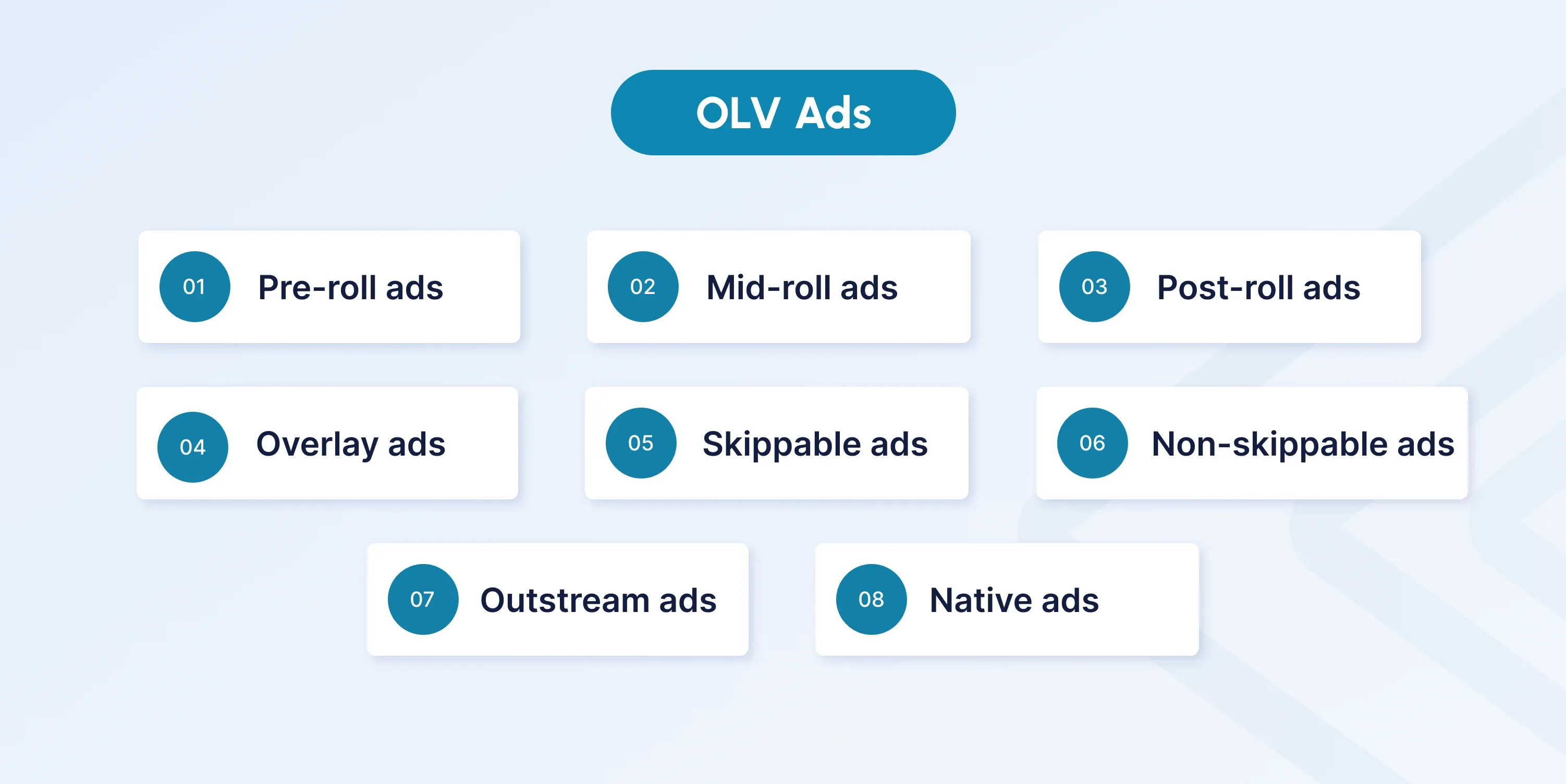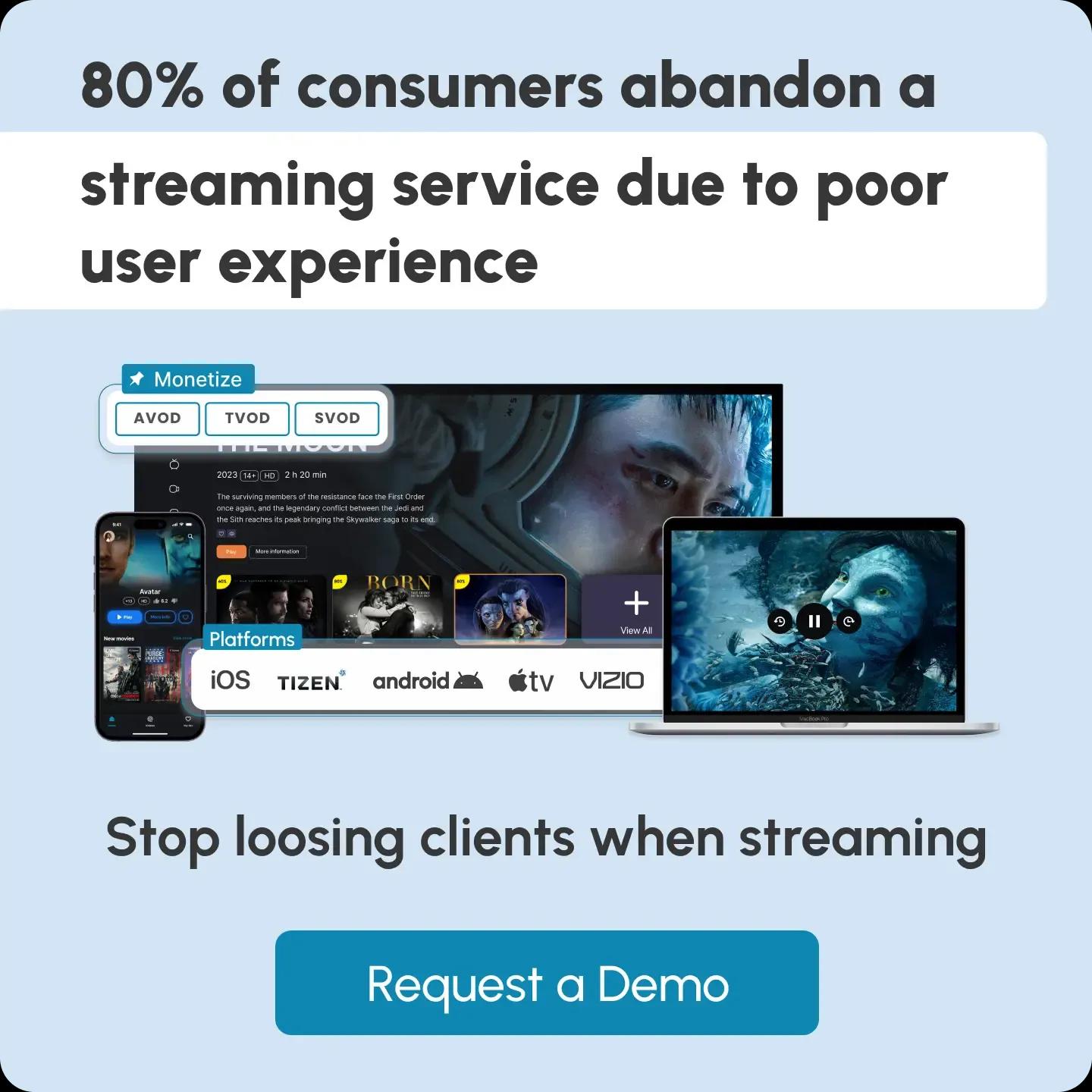
Effective OLV Advertising for Your Streaming Audience
Online Video (OLV) advertising is the key to capturing audience attention and driving revenue. But how do you make ads effective without disrupting the viewer experience? What strategies can be used, and how can you increase revenue with advertising?
There is not just one way to provide an uninterrupted experience for your audience. You can use different strategies to maximize viewer engagement.
This article will help you choose an OLV advertising strategy best suited for your business.

Key Takeaways
- OLV ads achieve higher engagement rates by leveraging audiences already immersed in streaming content, increasing lead generation potential.
- OLV advertising offers precise targeting capabilities, enabling brands to connect with specific audiences based on demographics, interests, and behavior.
- Various OLV ad formats, such as pre-roll, mid-roll, skippable, and native ads, cater to different audience preferences and viewing experiences.
- Measuring success through metrics like impressions, click-through rates, and video completion rates helps optimize campaigns and improve ROI.
What is OLV Advertising?
OLV advertising (online video advertising) is a digital marketing strategy that uses video ads to engage audiences across websites, social media, and streaming platforms. Unlike traditional TV commercials, OLV ads are designed for online consumption, allowing brands to target specific audiences based on demographics, interests, and online behavior.
In 2023, Statista reported that over three billion internet users were streaming or downloading videos every month.
With such a large audience to tap into, 91% of businesses turned to using online videos as a marketing tool in 2023. Since then, more and more companies have realized the potential of online video (OLV) advertising.
With the rise of video consumption on platforms like YouTube, Instagram, and streaming services, OLV marketing has become essential for businesses looking to boost brand awareness, drive conversions, and enhance customer engagement.
8 Types of OLV Ads
OLV advertising is a versatile and highly effective way to reach online audiences. With various ad formats tailored for different platforms, brands can engage viewers in multiple ways, whether through short-form social media videos or longer in-stream ads.
 Here are eight key types of OLV ads that marketers use to drive engagement and conversions:
Here are eight key types of OLV ads that marketers use to drive engagement and conversions:
1. Pre-roll ads
Pre-roll ads play before the main video begins, grabbing the users’ attention right before they engage with their intended content. Common examples are the ads that appear at the start of a YouTube video.
2. Mid-roll ads
These OLV ads pop up in the middle of the main video (often during natural breaks in programming) when the user is already engaged in the content.
For a company selling digital products and services, for example, it might be a good idea to feature ads in the middle of technology-focused content.
3. Post-roll ads
Post-roll ads show after the main video has finished, allowing brands to reinforce messaging or provide users with further information and/or follow-up actions.
While it may not garner as many viewers as pre- or mid-roll ads, post-roll ads offer the opportunity to reach an audience that has remained engaged and would be more likely to turn into leads.
4. Overlay ads
These are semi-transparent banners that appear over video content, typically at the bottom or outer edges of the screen.
Unlike pre-, mid-, or post-roll ads, overlay ads don’t interrupt video playback, making them a less disruptive form of advertising.
5. Skippable ads
Users can skip past these ads after a few seconds, allowing companies to grab their attention without being too intrusive.
6. Non-skippable ads
These require viewers to watch the full ad. A common example is bumper ads, which are brief, 6-second videos.
7. Outstream ads
These ads appear in non-video environments, such as within articles, websites, and games. Outstream ads usually start playing as viewers scroll or engage with content, capturing their attention mid-action.
8. Native ads
These ads have the same design as the content they are in, making the engagement more natural. Common examples are:
- Branded content – where streaming services partner with brands to create original content featuring their products or services.
- Sponsored recommendations – where streaming services use algorithmic recommendations to suggest sponsored content.
- Product placement – where streaming services feature brands’ products or services without changing their original content (like JBL headphones in a music video).
4 Benefits of OLV Advertising for OTT/Live Streaming Platforms
As OTT and live streaming platforms dominate digital media, OLV advertising has become a powerful tool for monetization and audience engagement.
 Unlike traditional TV ads, OLV ads are highly targeted, measurable, and adaptable, making them an ideal fit for streaming services.
Unlike traditional TV ads, OLV ads are highly targeted, measurable, and adaptable, making them an ideal fit for streaming services.
Targeted Approach
Unlike traditional TV advertising, OLV advertising lets you control who sees which content based on demographics, interests, online behavior, past interactions, and more. This gives users the personalized experiences they are looking for.
Higher Engagement Rates
With OLV advertising, you leverage an already engaged audience’s attention, creating a more immersive experience and higher lead generation.
Highly Measurable Results
OLV advertising lets you track user behavior (such as views, clicks, and interactions) in real-time using robust analytics and reporting tools.
This lets platforms constantly optimize user experience and ad campaigns to ensure the desired outcome.
Cross-device Compatibility
Because of their online nature, OLV ads can reach audiences across numerous devices, including smartphones, tablets, laptops, gaming consoles, and smart TVs.
Key Factors to Consider in OLV Advertising
To maximize the effectiveness of OLV advertising, brands and advertisers need to consider several key factors that impact performance, audience engagement, and ROI.
Ad Placement and Format Selection
Choosing between pre-roll, mid-roll, out-stream, or interactive ads depends on campaign goals and audience behavior. OTT platforms and social media require different strategies for optimal engagement.
Targeting and Personalization
OLV ads perform best when tailored to specific demographics, interests, and viewing habits. AI-driven targeting and programmatic ad buying ensure that ads reach the right audience at the right time.
User Experience and Ad Length
While shorter ads (6-15 seconds) work well for mobile and social media, longer in-stream ads (30+ seconds) can be more effective for OTT and live streaming platforms. Non-intrusive and skippable ad options improve user experience and retention.
Cross-platform Compatibility
Since OLV media is consumed across smart TVs, mobile devices, desktops, and tablets, ads must be optimized for different screen sizes and internet speeds.
Performance Tracking and Optimization
Measuring ad impressions, completion rates, click-through rates (CTR), and conversion rates helps fine-tune campaigns. A/B testing, retargeting, and real-time analytics ensure continuous improvement.
By focusing on these considerations, brands can create high-performing OLV ads that engage audiences, drive conversions, and maximize ad revenue across multiple platforms.
Content Types
It’s equally important to understand what kind of video content users prefer so you can present OLV ads that the audience would be more likely to engage with. According to Statista, the most popular video content types worldwide in 2024 were:
- Music videos (almost 50%)
- Comedy, meme, or viral video (35%)
- Video live stream (nearly 28%)
- Education videos (26%)
- Tutorial or how-to videos (25%)
- Sports clip or highlights video (25%)
- Product review video (25%)
- Influencer vlogs and videos (23%)
- Gaming videos (22%)
Best Practices for Effective OLV Advertising
There are some common techniques streaming OTT platforms and advertisers can employ to make the most of their OLV advertising, especially as users are at risk of facing ad fatigue.
These best practices include:
Identifying your target market
You can precisely match ads with the right viewers using identity-based data (like logins or transactions), ensuring brand engagement instead of just impressions. This means targeting your content to an audience that’s already interested in what you have to offer.
Understanding your audience
Knowing what resonates with your target market is crucial if you want them to engage with your brand. Using first-party data and digital insights to understand users’ interests, online behavior, and preferences can help you customize your content to ensure a better user experience.
Ensuring high-quality content
Investing in high-quality video production (such as crisp visuals, clear audio, and compelling storytelling) for your ads can help capture consumers’ attention and create a better user experience.
Compelling call to action
A successful OLV ad encourages users to take specific steps, like visiting a website, exploring more insights, or making a purchase. If users are uncertain about what they have to do, they might be less likely to engage. Ensure your call to action is clear and convincing.
Increasing exposure
By linking ads to multiple devices within a household, for example, you gain more control over how often users see ads, improving the chances of engagement.
Improving the interface
Use performance metrics and analytics tools to identify technical glitches (like long loading times or broken links) to improve the user experience.
A/B testing
To determine which versions viewers prefer, use comparative testing and performance metrics for various video campaign elements, such as thumbnails, titles, and calls to action.
Measuring OLV Advertising Success
To know whether your OLV ads are effective, you have to measure their performance based on a series of metrics, including:
- Impressions – total viewers (including repeat viewers)
- Revenue – capital generated
- Reach – unique viewers
- Frequency – how many times the ad was viewed
- Cost per view (CPV) – what the advertiser paid for each view
- Cost per thousand (CPM) – what the advertiser paid for every thousand views
- Video completion rate – how many viewers watched until the end
- ROAS – money spent versus revenue generated
- Click-through rates (CTR) – how many people click on the call to action
- Conversions: how many people completed the call to action as intended
- Cost per acquisition (CPA) – total revenue divided by conversions
- Viewer engagement – watch times, likes, shares, and comments
Streaming platforms can use different tools and technologies to help track OLV ads’ performance, such as:
- Google Analytics – provides insights into how users interact with your content (including demographics and behavior analytics).
- YouTube Analytics – provides insights into video performance metrics like watch times, traffic sources, and audience retention.
- Meta (social media analytics) provides insights into how videos perform on social media platforms
Many third-party video analytics tools also offer seamless client management, comprehensive analyses, and robust monetization tools.
inoRain, for example, provides powerful analytics and insights across various OTT platform metrics, including user management, statistics, reports, streaming monitoring, content management, billing, location metrics, transcoding management, as well as email and live TV notifications.
Future Trends in OLV Advertising
With all this potential, the popularity of OLV advertising on OTT platforms is set to increase in the coming years. However, platforms and advertisers must keep up with market trends to stay relevant.
Here are some future trends to look out for:
| Future Trend | Description | Statistics |
|---|---|---|
| More Mobile Users | The majority of video consumption happens on mobile devices, making mobile optimization essential. | 75% of all video viewing happens on mobile devices. |
| Vertical Videos Are Valuable | Platforms like TikTok, Instagram Stories, and YouTube Shorts prioritize vertical videos as they align with natural phone usage and create a more immersive experience. | Social media platforms prioritize vertical video content. |
| Shorter Video Content | Short-form videos cater to users with shorter attention spans and limited availability, making them highly engaging and shareable. | 69% of users trust recommendations from friends, family, or influencers over brands. |
| More Micro-Series | Short-form content is most effective when part of a larger narrative, keeping audiences engaged over time. | Short videos improve long-term engagement. |
| Longer Videos Returning | While short videos dominate, longer content is making a comeback for detailed product demos, educational content, and deeper storytelling. | TikTok now allows videos up to 10 minutes; YouTube Shorts allows videos up to 3 minutes. |
| Authenticity Leaves an Impact | Consumers prefer authentic, meaningful content that resonates emotionally. Brief but powerful moments can enhance audience connection. | 39% of consumers consider authenticity the most important factor in video content. |
| AI Takes Over | AI is increasingly used to enhance video production, particularly by small and medium-sized businesses. However, overuse may reduce authenticity. | AI-powered content creation is expanding but requires careful implementation to maintain user trust. |
| Education & Knowledge Exchange | More users are consuming educational video content, including tutorials, webinars, and authentic reviews. | 42% of users prefer videos where they can learn something new or gain encouragement. |
| Content E-Commerce | Marketers and creators are merging entertainment with shopping, using built-in e-commerce features on platforms like TikTok Shop and OTT services. | Social commerce is growing, allowing users to shop without leaving their content feed. |
Conclusion
As OLV advertising continues to evolve, trends like AI-driven targeting, vertical video formats, and interactive content reshape how brands engage with audiences.
Marketers must be agile, data-driven, and ready to embrace innovation to stay ahead. By adapting to these changes, OLV ads can remain impactful, meeting consumer expectations while driving long-term value for businesses.
Want to future-proof your OLV advertising strategy? Our experts at inoRain can help you navigate industry trends, optimize ad performance, and stay ahead of shifting market behaviors. Contact us today to take your OLV marketing to the next level.
FAQs
What is OLV advertising?
OLV (Online Video) advertising refers to digital video ads that play before, during, or after video content on websites, social media, and streaming platforms. These ads can be skippable or non-skippable and are often targeted based on user behavior, demographics, or interests to maximize engagement and conversions.
What is OLV advertising in the context of OTT and live streaming?
OTT platforms are streaming services that deliver video content directly to viewers over the internet. Examples include Netflix, Hulu, Disney+, Amazon Prime Video, and platforms like YouTube and TikTok. OLV advertising can be integrated into the user experience on these platforms through formats like pre-roll, mid-roll, or native ads.
What is OLV marketing?
OLV marketing (Online Video Marketing) refers to video ads delivered over the internet, typically on platforms like YouTube, Instagram, or streaming services, to promote products or services.
It enables precise audience targeting, performance tracking, and high engagement through formats like pre-roll, mid-roll, and out-stream video ads.
How does OLV differ from traditional TV advertising?
While TV advertising broadcasts the same message to a wide audience, OLV campaigns can personalize content for viewers based on detailed data, such as demographics, behavior, and preferences. Additionally, OLV provides measurable results through real-time analytics, enabling advertisers to track performance and optimize campaigns more effectively than traditional TV advertising.
How can OLV ads be targeted to specific audiences?
OLV ads use advanced targeting tools that leverage identity-based data, such as user logins, past interactions, and browsing behavior. This allows advertisers to deliver content tailored to specific demographics, interests, and viewing habits.
How does frequency capping help?
Frequency capping limits the number of times a user sees a specific ad within a certain time frame. This prevents overexposure, which can lead to ad fatigue and negative brand perception. By managing exposure levels, frequency capping helps maintain user engagement, optimize advertising budgets, and improve the overall effectiveness of campaigns.
Can OLV ads be integrated without disrupting the viewer experience?
Yes, OLV ads can be seamlessly integrated into streaming content to minimize disruption. Formats like overlay ads, native ads, and outstream ads blend naturally with the viewing experience, ensuring that users remain engaged.
Founder / CEO
Andranik is the CEO and Co-Founder of inoRain OTT and the Co-Founder of HotelSmarters, specializing in next-generation streaming technologies and digital transformation for the hospitality sector. He focuses on building innovative, scalable solutions for video delivery, OTT monetization, and data-driven hospitality management. His work bridges technical sophistication with practical business impact, helping organizations modernize their digital ecosystems and improve operational efficiency.

OTT Advertising: Types, Best Practices, and Strategies
Over-the-top (OTT) advertising has transformed how brands connect with consumers.

VPlayed Alternatives: inoRain vs. VPlayed
Explore inoRain as a VPlayed alternative, comparing features, pricing, and OTT solutions to find the best platform for your streaming needs.

Custom OTT Platform Development: How to Start an OTT Business
This guide will walk you through everything you need to know about the OTT platform development.
